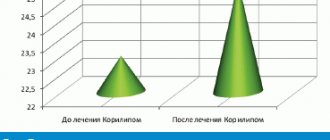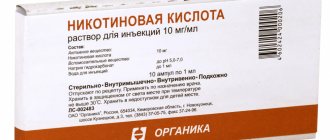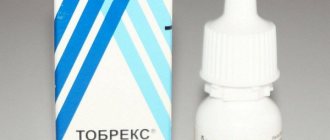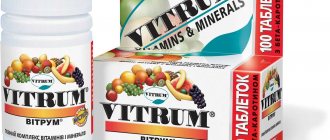Vitamin B10, or para-aminobenzoic acid, was discovered a long time ago, but it has not yet been fully studied. Every year our knowledge about this substance is replenished with new and sometimes quite unexpected data.
For a long time it was underestimated, although in fact para-aminobenzoic acid is responsible for the proper functioning of many vital processes. Therefore, in order for the body to function correctly, you need to maintain a normal level of this vitamin and, if necessary, take special dietary supplements.
History of Vitamin B10
Vitamin B10 (para-aminobenzoic acid) has many names: vitamin H1, 4-aminobenzoic acid, n-aminobenzoic acid, para-aminobenzoic acid (PABA).
It is an amino-containing derivative of benzoic acid, which is involved in many vital processes and is also responsible for the beauty of skin and hair.
Now Foods, PABA, 500 mg, 100 capsules
537 rub.
More details
Para-aminobenzoic acid was first synthesized in 1863 from yeast. Its ability to influence the production of melanin in the body was noted, but researchers were unable to establish the routes through which it enters the body, so PABA was classified as a vitamin.
Full research into the biochemical properties of the discovered compound began several decades later and continues to this day. They found that vitamin H1 is an amino acid and is part of folic acid. It enters the body in two ways: it is produced by intestinal microflora and penetrates through food. Therefore, both vitamin deficiency and excess are possible.
Sources
Vitamin B10 is one of the few vitamins that are synthesized directly in the human body. It is produced by beneficial bacteria in the intestines, breaking down coarse fibers. A certain amount of para-aminobenzoic acid is evacuated with feces, and the remaining part is involved in biochemical processes. It is not enough to satisfy all the needs of the body, so reserves are replenished during food processing. These are meat, liver, kidneys, dairy products, including cheeses, eggs, cereals, seeds and nuts.
Physicochemical characteristics
Para-aminobenzoic acid in its pure form is small yellow crystals, characterized by good solubility in ethyl alcohol and ether, but practically insoluble in water, boiling alkali or acid. The melting point is 185°C.
But vitamin H1 usually enters the body in the form of salts and esters, which are characterized by good solubility in water and other solvents.
The chemical formula of PABA has many similarities with the formula of novocaine (an anesthetic drug).
The empirical formula of para-aminobenzoic acid is C7H7NO2.
Para-aminobenzoic acid (PABA, Vitamin B10)
CAS number:
150-13-0
Gross formula:
C7H7NO2
Appearance:
white to light yellow crystalline powder
Chemical name and synonyms:
4-Aminobenzoic acid, 1-Amino-4- carboxybenzene;
p-Aminobenzoic acid; PABA, Vitamin Bx, Vitamin H1 Physico-chemical properties:
pH: 3.5 (0.5% aqueous solution). Molecular weight: 137.14 g/mol Density 1.374 g/cm3 Melting point 186-189 °C Solubility in water 4.7 g/l (20 ºC) Partition coefficient: n-octanol/water log Pow: 6.8 Storage: Do not store under direct sunlight. Store in a closed container. Keep under a nitrogen blanket. Recommended storage temperature: 2 - 8 ° C Chemical stability: para-aminobenzoic acid substance is stable at normal temperatures and pressures. May discolor when exposed to light. Air and light sensitive. Conditions to avoid: light, dust, exposure to air. Incompatibility with other materials: strong oxidizing agents. Hazardous decomposition products: carbon monoxide, nitrogen oxides, carbon dioxide.
Description:
Para-aminobenzoic acid (PABA) is an organic substance and non-protein amino acid containing benzoic acid in its structure. PABA is produced in sufficient quantities by the intestinal microflora and is also found in some foods. For example, it is found in mushrooms, yeast, nuts, sunflower seeds, bran, wheat germ, whole grains and some others. PABA is responsible for the formation of folic acid because it is part of its structure. PABA is responsible for the pigmentation of the skin and hair of humans and animals, thereby being an activator of the main enzyme in the biosynthesis of skin melanin. When used together with biotin, folic acid, pantothenic acid, and sometimes vitamin E, it can affect the restoration of hair structure. Some studies have shown that PABA is involved in the treatment of vitiligo (loss of color or pigmentation in certain areas of the skin). Also works in favor of red blood cell formation and acts as a coenzyme in protein metabolism and absorption.
PABA deficiency is an extremely rare occurrence when the intestines are functioning properly, since it is found in frequently consumed human foods and can be synthesized in the body by intestinal bacteria. However, deficiency can occur with prolonged use of antibiotics, namely sulfonamide drugs, which affect intestinal bacteria and thus the production of PABA.
Application:
The most common use of PABA dietary supplement is to support healthy skin and hair. It is also used to support healthy digestion and other biological functions, and oral PABA supplements may help relieve symptoms of irritable bowel syndrome. Additional health-related uses of PABA include assessing urinary sodium, nitrogen, and potassium levels.
PABA is also quite well known as a sunscreen component because it can absorb ultraviolet (UV) light. Therefore, it is included in sunscreens. PABA can restore gray hair to its original color when used with inositol, folic acid and pantothenic acid (vitamin B5) if gray hair is caused by stress or B vitamin deficiency. Oral PABA is used for certain diseases: vitiligo, pemphigus, dermatomyositis, morphea (skin disease , focal form of scleroderma), scleroderma and Peyronie's disease (clinical evidence suggests that PABA may reduce penile curvature and deterioration). PABA is also used orally to treat female infertility, arthritis, anemia, rheumatism, constipation, systemic lupus erythematosus, cutaneous lymphoblastoma and headaches. Potassium salt PABA is also used to treat fibrotic skin diseases.
Receipt:
Commercial production of PABA is usually carried out by reduction of 4-nitrobenzoic acid. Another method for producing PABA commercially uses terephthalic acid.
In detail, PABA is produced industrially by the catalytic hydrogenation of 4-nitrobenzoic acid using a platinum or palladium catalyst or reduction with tin or iron and hydrochloric acid.
Another reaction for the cleavage of terephthalic acid according to Hoffmann is a source of 4-aminobenzoic acid. Dimethyl terephthalate reacts with one equivalent of potassium hydroxide in methanol. The resulting salt is then amidated with liquid ammonia indimethylformamide at 130-140 °C to produce potassium terephthalate. It then reacts with a solution of sodium hypochlorite ("labarrack water") at a temperature of 50 - 92 ° C. The overall yield is approximately 70%. A two-step Hoffmann reaction was developed. The yield is 93%.
Para-aminobenzoic acid and its related compounds can also be obtained biologically using microorganisms and fermentable carbon substrates. Biologically derived PABA and related compounds from fermentable carbon substrates can be used in a number of applications, including as a food additive or feedstock for the synthesis of other industrial chemicals or polymers.
Effect on the body:
Humans do not synthesize PABA directly because they do not produce the necessary enzymes. E. coli in the intestine accomplishes this task using the enzymes 4-amino-4-deoxychorismate lyase and 4-amino-4-deoxychorismate synthase on chorismate (chorismic acid). Green plants can also synthesize PABA through their chloroplasts, which are structures containing chlorophyll.
PABA was once considered a B vitamin but is now considered an optional nutrient. Interestingly, pathogenic bacteria require PABA to synthesize folic acid. Sulfanilamide antibiotics have an antibacterial effect by inhibiting the synthesis of folic acid and PABA. Although blood, urine, sweat, and cerebrospinal fluid contain some amount of PABA, PABA deficiency has not been described in humans. Endogenous PABA appears to be involved in a number of biological processes, but its precise role is unknown. The bioavailability of PABA may decrease with age. Factors such as bacterial overgrowth due to chronic atrophic gastritis and decreased gastric acid secretion, which may occur with aging, may limit the absorption of PABA.
Toxicological data:
Oral administration, mouse: LD50 = 2850 mg/kg;
Oral administration, rabbit: LD50 = 1830 mg/kg;
Oral administration, rat: LD50 => 6 g/kg;
When administered orally, dog LD50 – 1000 mg/kg
Ecotoxicity:
Photobacterium phosphoreum bacteria: EC50 = 27.4 mg/l; 30 minutes.
Vitamin B10 and its effect on the human body
It will not be possible to briefly describe why the body needs vitamin B10, since it takes part in almost all processes. It is required for the synthesis of interferons, purines, pyrimidines, melanin pigment and maintaining a sufficient number of red blood cells.
Also para-aminobenzoic acid:
- stimulates lactation;
- necessary for the growth and reproduction of beneficial intestinal microflora;
- significant for maintaining the health and beauty of hair;
- ensures the production of thyroid hormones;
- maintains youthful skin by activating the production of collagen fibers;
- participates in lipid metabolism;
- protects the skin from the harmful effects of UV rays;
- ensures proper growth and development of children;
- participates in regenerative processes;
- prevents the formation of blood clots;
- increases the degree of absorption of other vitamins;
- has a sun protection effect.
Vitamin B10 exhibits pronounced antioxidant, immunostimulating, antiviral and antiallergic properties. Maintaining normal levels of para-aminobenzoic acid is an effective prevention:
- stroke;
- anemia;
- vein thrombosis;
- atherosclerosis;
- oncological diseases;
- early skin aging;
- liver cirrhosis.
The role of para-aminobenzoic acid in maintaining the beauty and youth of skin and hair is very important, as the doctor talks about in the following video:
How to get rid of gray hair without dyeing. Gray hair, what vitamins are missing?
Features of PABA entering the body and its absorption
Para-aminobenzoic acid is produced in the small intestine by representatives of beneficial microflora and is also supplied with food. The main sources are animal products. Therefore, vegetarians and adherents of strict diets often suffer from its deficiency.
After penetration into the gastrointestinal tract, vitamin B10 interacts with certain acids and is absorbed into the bloodstream, as a result of which it quickly spreads throughout the body and enters the cells of those organs that need it most.
Scientists suggest that one of its sources is foods rich in folic acid and its derivatives.
With active intake of para-aminobenzoic acid, it can be deposited in the liver, kidneys and brain. If the body is sufficiently saturated with it, the excess is gradually excreted through urine and feces. But with pathologies of the heart and blood vessels, its excretion slows down, which can provoke the development of signs of excess vitamin. But diseases of the gastrointestinal tract contribute to a lack of para-aminobenzoic acid, which has an extremely negative effect on the functioning of most organs and systems.
Source Naturals, Para-Aminobenzoic Acid (PABA), 100 mg, 250 Tablets
647 rub.
More details
During the period of bearing a child
Folic acid is a vitamin whose effectiveness and safety during pregnancy has been proven in numerous studies. Its daily intake can reduce the risk of congenital malformations of the fetus. Folic acid is especially important in the first trimester of pregnancy, since it is at this time that the neural tube of the embryo, the precursor of the spinal cord and brain, is formed. But without vitamin B10, its full absorption is impossible. Therefore, para-aminobenzoic acid can be prescribed to a woman in the form of pharmacological preparations.
Sources of vitamin B10 – table
| Product with para-aminobenzoic acid | Content per 100 g (mg) |
| Dry brewer's yeast | 5,7 |
| Beef and pork liver | 0,25 |
| Kidneys | 0,18 |
| Heart, brain | 0,135 |
| Mushrooms | 0,13 |
| Spinach, wheat cereal | 0,06 |
| Chicken eggs | 0,04 |
| Potato tubers | 0,036 |
| Carrots, white cabbage | 0,02 |
| Milk | 0,01 |
| Rice bran | < 0,01 |
| Sunflower seeds, pumpkin | |
| Parsley | |
| Melissa herb | |
| Yogurt, kefir and other fermented milk products | |
| Nuts | |
| Oat groats | |
| Fish | |
| Sesame |
Overdose
Vitamin B10 is synthesized in the body independently in sufficient quantities. It is almost impossible to get an overdose of it with food, since it is optimally distributed throughout the cells, and the excess is eliminated.
An overdose can only occur if the instructions for taking supplements are violated and the recommended amount is increased. Its symptoms are:
- nausea;
- disruption of the gastrointestinal tract;
- dizziness and headaches.
Individual intolerance to the components of the supplements is possible.
Vitamin H1 deficiency in adults and children: symptoms and consequences
If you have diseases of the gastrointestinal tract, insufficient consumption of foods containing vitamin B10, or their improper processing, a deficiency may be diagnosed.
Water, prolonged exposure to high temperatures and ethyl alcohol destroy para-aminobenzoic acid.
Also, its deficiency is often observed after long-term use of drugs from the group of NSAIDs, antibiotics, sulfonamides, hormonal therapy drugs, including estrogens, adrenaline, etc.
This is accompanied by:
- fragility, loss of shine, excessive hair loss;
- intestinal disorder;
- headaches, dizziness;
- premature appearance of gray hair;
- excessive fatigue;
- a decrease in the amount of milk or a complete cessation of lactation;
- developmental delays in children;
- nervousness, depression;
- more frequent occurrence of sunburn;
- the formation of age spots, various rashes on the skin;
- decreased libido.
With a deficiency of para-aminobenzoic acid, the likelihood of blood clots increases, which can lead not only to the development of thrombophlebitis, but also to stroke. To compensate for its deficiency, adjustments are made to the usual diet. But if regular consumption of animal products is impossible for one reason or another, special preparations and food supplements with vitamin b10 are used for this purpose, where it is contained in increased quantities.
Causes and signs of PABA deficiency and excess
Vitamin B10 deficiency is rare because the compound is widespread in nature and is found in many foods (see “Sources of para-aminobenzoic acid”).
Most often, a lack of PABA occurs due to long-term use of antibiotics, analgesics, antipyretics, estrogen-containing drugs or sulfonamides. In addition, improper storage and preparation of foods rich in vitamin H1 leads to loss of the beneficial nutrient. Para-aminobenzoic acid is destroyed under prolonged exposure to high temperatures (over 20 minutes) and from the action of alcohol.
Signs of para-aminobenzoic acid deficiency:
- irritability;
- weakness;
- headache;
- disorders of hormonal levels, gastrointestinal tract, nervous system;
- headache;
- developmental delay, growth;
- hair loss, fragility (baldness);
- depression;
- frequent sunburn;
- increased fatigue;
- the appearance of skin rashes, age spots, dermatological diseases;
- decreased lactation in lactating women.
Characteristic signs of excess vitamin H1 in the body:
- nausea;
- vomit;
- suppression of thyroid activity.
An excess of para-aminobenzoic acid in the body does not pose a threat to human life. Overdose symptoms go away after reducing the amount of the substance taken.
Excess PABA in adults and children: symptoms and consequences
Irrational use of folic acid preparations or those containing para-aminobenzoic acid separately for a long time can lead to an overdose of the vitamin and the development of signs of hypervitaminosis. It is less harmful than deficiency and is accompanied by:
- insufficient production of thyroid hormones;
- discomfort in the liver area;
- nausea, sometimes vomiting;
- intestinal disorders.
With a very long-term excess of PABA in the body, fatty infiltration of the liver and kidneys can occur, which leads to disruption of the heart.
To eliminate the consequences of excessive consumption of para-aminobenzoic acid, it is enough to stop taking products containing it. Since it is one of the water-soluble vitamins, it is quickly eliminated from the body in the urine and the person’s condition is completely normalized.
Country Life, PABA, Time Release, 1000 mg, 60 Tablets
970 rub.
More details
Interaction with other components
Ethyl alcohol reduces the concentration of B10, as the vitamin tries to neutralize its harmful effects on the body and is consumed more intensively.
You should not take PABA together with penicillin, it reduces the effectiveness of the drug.
Taking B10 together with folic and ascorbic acids, as well as vitamin B5, enhances their interaction.
Indications and instructions for use of para-aminobenzoic acid
Vitamin B10 is produced by various companies in the form of:
- tablets;
- capsules;
- solutions for injections in ampoules;
- eye drops;
- fine powder.
Para-aminobenzoic acid is also part of complex vitamin preparations. But in them it is present in small quantities, sufficient only to maintain normal levels of the vitamin daily, but not to compensate for its acute deficiency. They are taken according to the instructions.
Taking vitamin B10 in tablets or capsules is indicated for its deficiency in the body, which has not yet caused serious disorders:
- constant fatigue;
- increased skin sensitivity to sunlight;
- brittleness of hair and nail plates;
- frequent appearance of jams and cracks on the lips;
- early gray hair.
Also, the prescription of para-aminobenzoic acid preparations is of great practical importance for heavy mental or physical work, frequent stress, drinking alcohol or unhealthy food. It is used as a complement to complex therapy:
- developmental delays;
- arthritis;
- scleroderma;
- alopecia;
- anemia;
- vitiligo;
- Dupuytren's contracture and post-traumatic;
- burns;
- gastrointestinal diseases;
- mental disorders;
- climacteric changes;
- eye diseases;
- bronchial asthma;
- burns;
- pathologies of the heart and blood vessels.
Vitamin B 10 can also be used to improve a person’s condition while taking corticosteroids, sulfa drugs and anti-tuberculosis drugs.
In severe cases, injections of sterile solutions available in ampoules are indicated. And to effectively protect your skin from sun rays, you can buy special sprays and lip balms with para-aminobenzoic acid.
Indications for use and contraindications
Vitamin B10 is used in medicine to eliminate the following painful conditions:
- neuro-emotional stress;
- arthritis and arthrosis;
- vitiligo diseases;
- alopecia;
- physical and mental fatigue;
- anemia (folate deficiency);
- Dupuytren's contracture;
- stress;
- skin diseases, in particular itchy dermatoses;
- Peyronie's disease;
- scleroderma;
- delays in development, growth;
- menopause;
- brittle nails;
- ultraviolet burns;
- atherosclerosis;
- rheumatism;
- emphysema;
- pneumosclerosis;
- bronchial asthma;
- chronic coronary insufficiency;
- hepatitis A;
- cerebral vascular sclerosis;
- liver cirrhosis at the initial stage;
- chronic alcohol intoxication.
In addition, para-aminobenzoic acid is used to strengthen hair, improve tolerance of corticosteroids, sulfonamides, and anti-tuberculosis drugs.
Contraindications for taking PABA include:
- hypervitaminosis;
- disorders of the thyroid gland;
- sensitivity to the drug.
In 90% of cases, vitamin B10 is well absorbed by the body, with sufficient folic acid intake, without causing adverse reactions.
In a healthy person (without gastrointestinal problems) with a balanced diet, compound H1 is synthesized by the intestinal microflora.
Absorption of PABA occurs in the upper intestine. At the same time, part of the compound is used by the microflora of the large intestine to synthesize vitamin B9. The concentration of para-aminobenzoic acid in human blood ranges from 2 to 70 micrograms per deciliter.
The compound is excreted in the urine in acetylated form. The level of PABA in the body depends on the state of a person’s health: with gastric ulcers, chronic hepatitis, cholecystitis, Botkin’s disease, it decreases, and if there are problems with the cardiovascular system, it increases. 250 micrograms of the nutrient are excreted in feces.
Links[edit]
- van de Graaff, Bas (1981). “Replacement effects. 7. Microscopic dissociation constants of 4-amino- and 4-(dimethylamino) benzoic acid.” J. Org.
Chem .
46
(4):653–657. - Haynes, William M., ed. (2016). CRC Handbook of Chemistry and Physics (97th ed.). CRC Press. paragraph 5–89. ISBN 978-1498754286.
- ^ a b Maki, T.; Takeda, K. (2000). "Benzoic acid and derivatives". Ullman Encyclopedia of Industrial Chemistry
. Wiley-VCH. DOI: 10.1002/14356007.a03_555. ISBN 3527306730. - "Food Resource for Health". Archived from the original on 2009-12-16. Retrieved November 21, 2009.
- Kluczyk, Alicia; Popek, Tomas; Kiyota, Taira; de Macedo, Pierre; Stefanovich, Peter; Lazar, Carmen; Konishi, Yasuo (2002). "Drug Development: p-Aminobenzoic Acid as a Building Block". Modern medicinal chemistry
.
9
(21): 1871–1892. DOI: 10.2174/0929867023368872. ISSN 0929-8673. PMID 12369873. - ^ ab "Para-aminobenzoic acid". Medline Plus Medical Encyclopedia
. US National Institutes of Health. Retrieved January 24, 2014. - Synthesis of folic acid (Abstract)
- Brown G. M. (1962). “Biosynthesis of folic acid. II. Inhibition by sulfonamides". J Biol. Chem
.
237
(2):536–40. DOI: 10.1016/S0021-9258(18)93957-8. PMID 13873645. - "Compound Resume on PubChem". PubChem
. National Institutes of Health: National Library of Medicine. 2006. Retrieved April 5, 2006. - "PABA's Health (Supplement) Library". Archived from the original on August 4, 2017. Retrieved August 4, 2021.
- Melanoma Madness Science Brief on Sunscreens and Skin Cancer - Chemical Research, Science News Online, 6/6/98 (accessed 10/1/2009, 2009)
- Rahal, R.; Daniele, S.; Hubert-Pfalzgraf, L.G.; Guyot-Ferréol, V.; Tranchant, J (2008). "Synthesis of para-aminobenzoic acid–TiO2 hybrid nanostructures of controlled functionality using an aqueous one-step process." European Journal of Inorganic Chemistry
.
2008
(6):980–987. DOI: 10.1002/ejic.200700971.CS1 maint: uses the authors parameter (link) - FP; Mitchnick, M.; Nash, J.F. Review of the safety and effectiveness of Photochem sunscreen. Photobiol. 1998, 68, 243 256.
- H.; Thune, P.; Eeg Larsen, T. Inhibitory effect of PABA on Arch photocarcinogenesis. Dermatol. Res. 1990, 282, 38 41
- Osgood, Pauline J.; Moss, Stephen H.; Davis, David J. G. (1982). "Sensitization of mammalian cell killing by near-ultraviolet radiation by the sunscreen agent para-aminobenzoic acid". Journal of Investigative Dermatology
.
79
(6): 354–7. DOI: 10.1111/1523-1747.ep12529409. PMID 6982950. - [1], “Matte cosmetic compositions”
- Rahal, R.; Daniele, S.; Hubert-Pfalzgraf, L.G.; Guyot-Ferréol, V.; Tranchant, J (2008). "Synthesis of para-aminobenzoic acid–TiO2 hybrid nanostructures of controlled functionality using an aqueous one-step process." European Journal of Inorganic Chemistry
.
2008
(6):980–987. DOI: 10.1002/ejic.200700971.CS1 maint: uses the authors parameter (link) - Toxicity, local anesthetics: emergency medicine eMedicine






